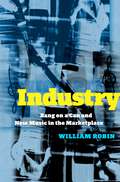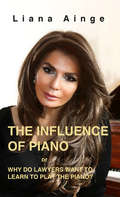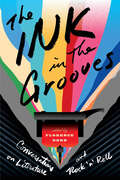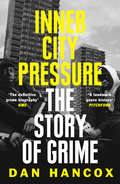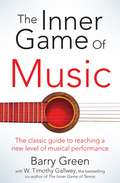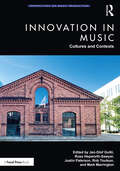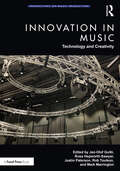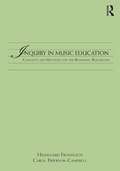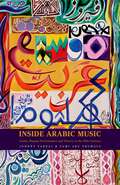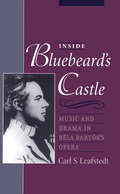- Table View
- List View
Industry: Bang on a Can and New Music in the Marketplace
by William RobinAmidst the heated fray of the Culture Wars emerged a scrappy festival in downtown New York City called Bang on a Can. Presenting eclectic, irreverent marathons of experimental music in crumbling venues on the Lower East Side, Bang on a Can sold out concerts for a genre that had been long considered box office poison. Through the 1980s and 1990s, three young, visionary composers--David Lang, Michael Gordon, and Julia Wolfe--nurtured Bang on a Can into a multifaceted organization with a major record deal, a virtuosic in-house ensemble, and a seat at the table at Lincoln Center, and in the process changed the landscape of avant-garde music in the United States. Bang on a Can captured a new public for new music. But they did not do so alone. As the twentieth century came to a close, the world of American composition pivoted away from the insular academy and towards the broader marketplace. In the wake of the unexpected popularity of Steve Reich and Philip Glass, classical presenters looked to contemporary music for relevance and record labels scrambled to reap its potential profits, all while government funding was imperilled by the evangelical right. Other institutions faltered amidst the vagaries of late capitalism, but the renegade Bang on a Can survived--and thrived--in a tumultuous and idealistic moment that made new music what it is today.
Infant Musicality: New Research for Educators and Parents
by Johannella TafuriWhat can infants hear? What are their reactions to music? Is it useful for them to sing and listen to music? Is their auditory sensitivity developed before their birth? At what age do they start singing, and clapping their hands? How can their musical development be improved? These (and other) questions are present in today's debate on music education and the responses are normally given in an intuitive way. It is now necessary and urgent to sketch a developmental profile of infants, starting from their earliest manifestations. In the last 30 years, research in this field has been progressively developed. In most cases research has been devoted to single aspects of more complex problems. Moreover, it has been based on non-homogeneous categories of subjects and by different methods. Motivated by the fact that many open problems need to be solved, Professor Tafuri decided, in 1998, to begin a longitudinal research project devoted to studying the musical development in children from 0 to 6 years, with particular attention on the ability to sing in tune. During these 6 years, the children would have a regular music education experience with their mothers and often other members of the immediate family. This book has two main areas of focus. The first reconstructs the development of human musical abilities. Tafuri systematically reports studies of the development of vocal, rhythmic and motor abilities through the observation of the same participants for three years, beginning with the mothers' experiences in the last three months of pre-natal life. The programme of musical activities and the modalities of the collaboration with the parents are described. The second area of focus puts forward an educational perspective based on the results of the research. The amount and the quality of the collected data can allow parents and educators to plan different activities by considering the starting point for individual participants and the development of the
Infant Musicality: New Research for Educators and Parents
by Johannella TafuriWhat can infants hear? What are their reactions to music? Is it useful for them to sing and listen to music? Is their auditory sensitivity developed before their birth? At what age do they start singing, and clapping their hands? How can their musical development be improved? These (and other) questions are present in today's debate on music education and the responses are normally given in an intuitive way. It is now necessary and urgent to sketch a developmental profile of infants, starting from their earliest manifestations. In the last 30 years, research in this field has been progressively developed. In most cases research has been devoted to single aspects of more complex problems. Moreover, it has been based on non-homogeneous categories of subjects and by different methods. Motivated by the fact that many open problems need to be solved, Professor Tafuri decided, in 1998, to begin a longitudinal research project devoted to studying the musical development in children from 0 to 6 years, with particular attention on the ability to sing in tune. During these 6 years, the children would have a regular music education experience with their mothers and often other members of the immediate family. This book has two main areas of focus. The first reconstructs the development of human musical abilities. Tafuri systematically reports studies of the development of vocal, rhythmic and motor abilities through the observation of the same participants for three years, beginning with the mothers' experiences in the last three months of pre-natal life. The programme of musical activities and the modalities of the collaboration with the parents are described. The second area of focus puts forward an educational perspective based on the results of the research. The amount and the quality of the collected data can allow parents and educators to plan different activities by considering the starting point for individual participants and the development of the
The Influence of Piano
by Liana AingeWhy do lawyers want to learn to play the piano? At first sight jurisprudence, with its exhaustive logic, rules and standard tasks, is poles apart from the sensual world of music, but in reality it just seems so. Although this book will be of particular interest to lawyers it also will have a much wider appeal to anyone who is dedicated to learning the piano from beginners to professionals. By reading this book, you will learn how and why training in music develops logical, abstract and creative thinking, and contributes to success in every sphere of human life. www.pianoprimalessons.co.uk
The Ink in the Grooves: Conversations on Literature and Rock 'n' Roll
by Florence DoreDrop the record needle on any vinyl album in your collection, then read the first pages of that novel you've been meaning to pick up—the reverberations between them will be impossible to miss. Since Dylan went electric, listening to rock 'n' roll has often been a surprisingly literary experience, and contemporary literature is curiously attuned to the history and beat of popular music. In The Ink in the Grooves, Florence Dore brings together a remarkable array of acclaimed novelists, musicians, and music writers to explore the provocatively creative relationship between musical and literary inspiration: the vitality that writers draw from a three-minute blast of guitars and the poetic insights that musicians find in literary works from Shakespeare to Southern Gothic. Together, the essays and interviews in The Ink in the Grooves provide a backstage pass to the creative processes behind some of the most exciting and influential albums and novels of our time.Contributors: Laura Cantrell, Michael Chabon, Roddy Doyle, Bob Dylan, Steve Earle, William Ferris, Dom Flemons, Rhiannon Giddens, Dave Grohl, Peter Guralnick, Amy Helm, Randall Kenan, Jonathan Lethem, Greil Marcus, Rick Moody, Lorrie Moore, the John Prine band (Dave Jacques, Fats Kaplin, Pat McLaughlin, Jason Wilber), Dana Spiotta, John Jeremiah Sullivan, Richard Thompson, Scott Timberg, Daniel Wallace, Colson Whitehead, Lucinda Williams, Warren Zanes.
Ink on the Tracks: Rock and Roll Writing
by Edited by Andrew McKeown and Adrian GrafeThis book embraces the multiplicity of forms of writing inspired by rock and roll.Exploring a diverse range of formats including rock autobiography and gender, race and class in American rock journalism, rock obituaries, rock literature and spirituality, rock writing and promotion/packaging, and more, this book identifies and prioritizes writing forms often excluded from the categorization of rock music writing. Vitally, the volume places rock and roll writing within a wider cultural frame often overlooked by studies of traditional white male-led music journalism.
Ink on the Tracks: Rock and Roll Writing
This book embraces the multiplicity of forms of writing inspired by rock and roll.Exploring a diverse range of formats including rock autobiography and gender, race and class in American rock journalism, rock obituaries, rock literature and spirituality, rock writing and promotion/packaging, and more, this book identifies and prioritizes writing forms often excluded from the categorization of rock music writing. Vitally, the volume places rock and roll writing within a wider cultural frame often overlooked by studies of traditional white male-led music journalism.
Inner City Pressure: The Story of Grime
by Dan HancoxA GUARDIAN, OBSERVER, PITCHFORK, NPR, METRO AND HERALD SCOTLAND BEST MUSIC BOOK OF 2018 ‘The definitive grime biography’ NME ’A landmark genre history’ Pitchfork
The Inner Game Of Music
by Barry Green W. Timothy GallweyThe bestselling guide to improving musical performanceThe Inner Game of Music is the battle that all musicians have to fight against elusive opponents such as nervousness, self-doubt and fear of failure. Using the world-famous Inner Game principles, developed by bestselling author Timothy Gallwey, acclaimed musician Barry Green explains the basic principles of 'natural learning' and shows how you can apply them to reach a new level of musical application and performance. In precise, easy to understand language, Green and Gallwey explain how natural skills - such as awareness, trust and willpower - can be nurtured and enhanced. Through a series of tailored exercises The Inner Game of Music demonstrates the ways in which musicians can achieve exact intonations, artistic phrasing and improved technique. There are also chapters on ensemble playing, improvisation, composition and creativity, as well as listening skills - an essential part of the Inner Game. Following a methodology with a proven track record for generations of aspiring and professional musicians, The Inner Game of Music is invaluable to anyone seriously interested in music, and is guaranteed to deliver positive results whether you are a student, teacher, performer, or simply an appreciative listener.
The Inner Game of Music
by W Timothy Gallwey Barry GreenThe bestselling guide to improving musical performance The Inner Game of Music is the battle that all musicians have to fight against elusive opponents such as nervousness, self-doubt and fear of failure. Using the world-famous Inner Game principles, developed by bestselling author Timothy Gallwey, acclaimed musician Barry Green explains the basic principles of 'natural learning' and shows how you can apply them to reach a new level of musical application and performance. In precise, easy to understand language, Green and Gallwey explain how natural skills - such as awareness, trust and willpower - can be nurtured and enhanced. Through a series of tailored exercises The Inner Game of Music demonstrates the ways in which musicians can achieve exact intonations, artistic phrasing and improved technique. There are also chapters on ensemble playing, improvisation, composition and creativity, as well as listening skills - an essential part of the Inner Game. Following a methodology with a proven track record for generations of aspiring and professional musicians, The Inner Game of Music is invaluable to anyone seriously interested in music, and is guaranteed to deliver positive results whether you are a student, teacher, performer, or simply an appreciative listener.
Inner Sound: Altered States of Consciousness in Electronic Music and Audio-Visual Media
by Jonathan WeinelOver the last century, developments in electronic music and art have enabled new possibilities for creating audio and audio-visual artworks. With this new potential has come the possibility for representing subjective internal conscious states, such as the experience of hallucinations, using digital technology. Combined with immersive technologies such as virtual reality goggles and high-quality loudspeakers, the potential for accurate simulations of conscious encounters such as Altered States of Consciousness (ASCs) is rapidly advancing. In Inner Sound, author Jonathan Weinel traverses the creative influence of ASCs, from Amazonian chicha festivals to the synaesthetic assaults of neon raves; and from an immersive outdoor electroacoustic performance on an Athenian hilltop to a mushroom trip on a tropical island in virtual reality. Beginning with a discussion of consciousness, the book explores how our subjective realities may change during states of dream, psychedelic experience, meditation, and trance. Taking a broad view across a wide range of genres, Inner Sound draws connections between shamanic art and music, and the modern technoshamanism of psychedelic rock, electronic dance music, and electroacoustic music. Going beyond the sonic into the visual, the book also examines the role of altered states in film, visual music, VJ performances, interactive video games, and virtual reality applications. Through the analysis of these examples, Weinel uncovers common mechanisms, and ultimately proposes a conceptual model for Altered States of Consciousness Simulations (ASCSs). This theoretical model describes how sound can be used to simulate various subjective states of consciousness from a first-person perspective, in an interactive context. Throughout the book, the ethical issues regarding altered states of consciousness in electronic music and audio-visual media are also examined, ultimately allowing the reader not only to consider the design of ASCSs, but also the implications of their use for digital society.
INNER SOUND C: Altered States of Consciousness in Electronic Music and Audio-Visual Media
by Jonathan WeinelOver the last century, developments in electronic music and art have enabled new possibilities for creating audio and audio-visual artworks. With this new potential has come the possibility for representing subjective internal conscious states, such as the experience of hallucinations, using digital technology. Combined with immersive technologies such as virtual reality goggles and high-quality loudspeakers, the potential for accurate simulations of conscious encounters such as Altered States of Consciousness (ASCs) is rapidly advancing. In Inner Sound, author Jonathan Weinel traverses the creative influence of ASCs, from Amazonian chicha festivals to the synaesthetic assaults of neon raves; and from an immersive outdoor electroacoustic performance on an Athenian hilltop to a mushroom trip on a tropical island in virtual reality. Beginning with a discussion of consciousness, the book explores how our subjective realities may change during states of dream, psychedelic experience, meditation, and trance. Taking a broad view across a wide range of genres, Inner Sound draws connections between shamanic art and music, and the modern technoshamanism of psychedelic rock, electronic dance music, and electroacoustic music. Going beyond the sonic into the visual, the book also examines the role of altered states in film, visual music, VJ performances, interactive video games, and virtual reality applications. Through the analysis of these examples, Weinel uncovers common mechanisms, and ultimately proposes a conceptual model for Altered States of Consciousness Simulations (ASCSs). This theoretical model describes how sound can be used to simulate various subjective states of consciousness from a first-person perspective, in an interactive context. Throughout the book, the ethical issues regarding altered states of consciousness in electronic music and audio-visual media are also examined, ultimately allowing the reader not only to consider the design of ASCSs, but also the implications of their use for digital society.
Innovation in Music: Future Opportunities (Perspectives on Music Production)
by Russ Hepworth-SawyerInnovation in Music: Future Opportunities brings together cutting-edge research on new innovations in the field of music production, technology, performance and business. Including contributions from a host of well-respected researchers and practitioners, this volume provides crucial coverage on a range of topics from cybersecurity, to accessible music technology, performance techniques and the role of talent shows within music business. Innovation in Music: Future Opportunities is the perfect companion for professionals and researchers alike with an interest in the music industry.
Innovation in Music: Future Opportunities (Perspectives on Music Production)
by Russ Hepworth-Sawyer Justin Paterson Rob ToulsonInnovation in Music: Future Opportunities brings together cutting-edge research on new innovations in the field of music production, technology, performance and business. Including contributions from a host of well-respected researchers and practitioners, this volume provides crucial coverage on a range of topics from cybersecurity, to accessible music technology, performance techniques and the role of talent shows within music business. Innovation in Music: Future Opportunities is the perfect companion for professionals and researchers alike with an interest in the music industry.
Innovation in Music: Cultures and Contexts (ISSN)
by Jan-Olof Gullö Russ Hepworth-Sawyer Justin Paterson Rob Toulson Mark MarringtonInnovation in Music: Cultures and Contexts is a groundbreaking collection bringing together contributions from instructors, researchers, and professionals. Split into two sections, covering creative production practices and national/international perspectives, this volume offers truly global outlooks on ever-evolving practices.Including chapters on Dolby Atmos, the history of distortion, creativity in the pandemic, and remote music collaboration, this is recommended reading for professionals, students, and researchers looking for global insights into the fields of music production, music business, and music technology.
Innovation in Music: Cultures and Contexts (ISSN)
Innovation in Music: Cultures and Contexts is a groundbreaking collection bringing together contributions from instructors, researchers, and professionals. Split into two sections, covering creative production practices and national/international perspectives, this volume offers truly global outlooks on ever-evolving practices.Including chapters on Dolby Atmos, the history of distortion, creativity in the pandemic, and remote music collaboration, this is recommended reading for professionals, students, and researchers looking for global insights into the fields of music production, music business, and music technology.
Innovation in Music: Technology and Creativity (ISSN)
by Jan-Olof Gullö Russ Hepworth-Sawyer Justin Paterson Rob Toulson Mark MarringtonInnovation in Music: Technology and Creativity is a groundbreaking collection bringing together contributions from instructors, researchers, and professionals. Split into two sections, covering composition and performance, and technology and innovation, this volume offers truly international perspectives on ever-evolving practices.Including chapters on audience interaction, dynamic music methods, AI, and live electronic performances, this is recommended reading for professionals, students, and researchers looking for global insights into the fields of music production, music business, and music technology.
Innovation in Music: Technology and Creativity (ISSN)
Innovation in Music: Technology and Creativity is a groundbreaking collection bringing together contributions from instructors, researchers, and professionals. Split into two sections, covering composition and performance, and technology and innovation, this volume offers truly international perspectives on ever-evolving practices.Including chapters on audience interaction, dynamic music methods, AI, and live electronic performances, this is recommended reading for professionals, students, and researchers looking for global insights into the fields of music production, music business, and music technology.
Inquiry in Music Education: Concepts and Methods for the Beginning Researcher
by Carol Frierson-Campbell Hildegard C. FroehlichInquiry in Music Education: Concepts and Methods for the Beginning Researcher, Second Edition, introduces research and scholarship in music education as an ongoing spiral of inquiry. Exploring research conventions that are applicable beyond music to the other arts and humanities as well, it offers a sequential approach to topic formulation, information literacy, reading and evaluating research studies, and planning and conducting original studies within accepted guidelines. Following the legacy begun by Edward Rainbow and Hildegard C. Froehlich, this book expands what is meant by music education and research, teaching tangible skills for music educators with diverse instructional goals and career aspirations. The second edition addresses the changes in methods due to technological advances, a proliferation of new scholarship, and an awareness of the impact of place and culture on researchers and research participants. This edition features: the most current information on research tools, strategies to remain up-to-date, and expanded supplemental online materials (see inquiryinmusiceducation.com) case studies that reflect recent research and discuss issues of gender, race, and culture previously absent from mainstream scholarship an acknowledgment of the assessment demands of contemporary K-12 schooling a chapter devoted to mixed methods, arts-based, and practitioner inquiry assignments and other resources designed to be friendly for online course delivery chapters from contributing authors Debbie Rohwer and Marie McCarthy, bringing additional depth and perspective. Inquiry in Music Education provides students with the language, skills, and protocols necessary to succeed in today’s competitive markets of grant writing, arts advocacy, and public outreach as contributing members of the community of music educators.
Inquiry in Music Education: Concepts and Methods for the Beginning Researcher
by Carol Frierson-Campbell Hildegard C. FroehlichInquiry in Music Education: Concepts and Methods for the Beginning Researcher, Second Edition, introduces research and scholarship in music education as an ongoing spiral of inquiry. Exploring research conventions that are applicable beyond music to the other arts and humanities as well, it offers a sequential approach to topic formulation, information literacy, reading and evaluating research studies, and planning and conducting original studies within accepted guidelines. Following the legacy begun by Edward Rainbow and Hildegard C. Froehlich, this book expands what is meant by music education and research, teaching tangible skills for music educators with diverse instructional goals and career aspirations. The second edition addresses the changes in methods due to technological advances, a proliferation of new scholarship, and an awareness of the impact of place and culture on researchers and research participants. This edition features: the most current information on research tools, strategies to remain up-to-date, and expanded supplemental online materials (see inquiryinmusiceducation.com) case studies that reflect recent research and discuss issues of gender, race, and culture previously absent from mainstream scholarship an acknowledgment of the assessment demands of contemporary K-12 schooling a chapter devoted to mixed methods, arts-based, and practitioner inquiry assignments and other resources designed to be friendly for online course delivery chapters from contributing authors Debbie Rohwer and Marie McCarthy, bringing additional depth and perspective. Inquiry in Music Education provides students with the language, skills, and protocols necessary to succeed in today’s competitive markets of grant writing, arts advocacy, and public outreach as contributing members of the community of music educators.
Inquiry in Music Education: Concepts and Methods for the Beginning Researcher
by Hildegard Froehlich Carol Frierson-CampbellInquiry in Music Education: Concepts and Methods for the Beginning Researcher provides an introduction to research and scholarship in music education. This textbook covers topic formulation, information literacy, reading and evaluating research studies, and planning and conducting original studies within accepted guidelines, based on research conventions in music, the other arts, education, and the humanities. Electronic search tools, hands-on assignments, supplementary teaching materials and other resources are included on the companion web site (available January 2013). Skills in research and scholarship introduce students to the language and protocols by which to succeed in today’s competitive market of grant writing, arts advocacy, and public outreach as a contributing member of the community of music educators. Following the legacy begun by Rainbow and Froehlich in Research in Music Education, published in 1987, the objectives of this book are: To expand what is meant by music education and research, To help students find their niche in those definitions, and To teach tangible skills that are useful for music educators with diverse instructional goals and career aspirations.
Inquiry in Music Education: Concepts and Methods for the Beginning Researcher
by Hildegard Froehlich Carol Frierson-CampbellInquiry in Music Education: Concepts and Methods for the Beginning Researcher provides an introduction to research and scholarship in music education. This textbook covers topic formulation, information literacy, reading and evaluating research studies, and planning and conducting original studies within accepted guidelines, based on research conventions in music, the other arts, education, and the humanities. Electronic search tools, hands-on assignments, supplementary teaching materials and other resources are included on the companion web site (available January 2013). Skills in research and scholarship introduce students to the language and protocols by which to succeed in today’s competitive market of grant writing, arts advocacy, and public outreach as a contributing member of the community of music educators. Following the legacy begun by Rainbow and Froehlich in Research in Music Education, published in 1987, the objectives of this book are: To expand what is meant by music education and research, To help students find their niche in those definitions, and To teach tangible skills that are useful for music educators with diverse instructional goals and career aspirations.
Inside Arabic Music: Arabic Maqam Performance and Theory in the 20th Century
by Johnny Farraj Sami Abu ShumaysWhat makes hundreds of listeners cheer ecstatically at the same instant during a live concert by Egyptian diva Umm Kulthum? What is the unspoken language behind a taqsim (traditional instrumental improvisation) that performers and listeners implicitly know? How can Arabic music be so rich and diverse without resorting to harmony? Why is it so challenging to transcribe Arabic music from a recording? Inside Arabic Music answers these and many other questions from the perspective of two "insiders" to the practice of Arabic music, by documenting a performance culture and a know-how that is largely passed on orally. Arabic music has spread across the globe, influencing music from Greece all the way to India in the mid-20th century through radio and musical cinema, and global popular culture through Raqs Sharqi, known as "Bellydance" in the West. Yet despite its popularity and influence, Arabic music, and the maqam scale system at its heart, remain widely misunderstood. Inside Arabic Music de-mystifies maqam with an approach that draws theory directly from practice, and presents theoretical insights that will be useful to practitioners, from the beginner to the expert - as well as those interested in the related Persian, Central Asian, and Turkish makam traditions. Inside Arabic Music's discussion of maqam and improvisation widens general understanding of music as well, by bringing in ideas from Saussurean linguistics, network theory, and Lakoff and Johnson's theory of cognition as metaphor, with an approach parallel to Gjerdingen's analysis of Galant-period music - offering a lens into the deeper relationships among music, culture, and human community.
INSIDE ARABIC MUSIC C: Arabic Maqam Performance and Theory in the 20th Century
by Johnny Farraj Sami Abu ShumaysWhat makes hundreds of listeners cheer ecstatically at the same instant during a live concert by Egyptian diva Umm Kulthum? What is the unspoken language behind a taqsim (traditional instrumental improvisation) that performers and listeners implicitly know? How can Arabic music be so rich and diverse without resorting to harmony? Why is it so challenging to transcribe Arabic music from a recording? Inside Arabic Music answers these and many other questions from the perspective of two "insiders" to the practice of Arabic music, by documenting a performance culture and a know-how that is largely passed on orally. Arabic music has spread across the globe, influencing music from Greece all the way to India in the mid-20th century through radio and musical cinema, and global popular culture through Raqs Sharqi, known as "Bellydance" in the West. Yet despite its popularity and influence, Arabic music, and the maqam scale system at its heart, remain widely misunderstood. Inside Arabic Music de-mystifies maqam with an approach that draws theory directly from practice, and presents theoretical insights that will be useful to practitioners, from the beginner to the expert - as well as those interested in the related Persian, Central Asian, and Turkish makam traditions. Inside Arabic Music's discussion of maqam and improvisation widens general understanding of music as well, by bringing in ideas from Saussurean linguistics, network theory, and Lakoff and Johnson's theory of cognition as metaphor, with an approach parallel to Gjerdingen's analysis of Galant-period music - offering a lens into the deeper relationships among music, culture, and human community.
Inside Bluebeard's Castle: Music and Drama in Béla Bartók's Opera
by Carl S. LeafstedtThis is the first book-length examination of Bartók's 1911 opera Duke Bluebeard's Castle, one of the twentieth century's enduring operatic works. Writing in an engaging style, Leafstedt adopts an interdisciplinary approach to the opera by introducing, in addition to music-dramatic analysis, a number of topics that are new to the field of Bartók studies. These new areas of critical and scholarly terrain include a detailed literary study of the libretto and a gender-focused analysis of the opera's female character, Judith. Leafstedt begins with a short introductory chapter that places Duke Bluebeard's Castle within the context of Bartók's early composing career, his discovery of folk music, and its impact on his later work. The book goes on to explore the composition's troubled history, its failure to win two early Hungarian opera competitions, and the three versions of the ending that resulted, discussed here in depth for the first time. The core of the book is devoted to the musical and dramatic organization of the opera and offers an analysis of the seven individual door scenes, including a detailed analysis of scene six, the "lake of tears" scene, illustrating the work's complex tonal organization and dramatic structure. A separate chapter places this darkly psychological version of the Bluebeard story within the broader context of European history and literature. Throughout the book, Leafstedt draws on original Hungarian source material, much of it newly translated by the author and available here for the first time in English, and he includes a generous selection of musical examples. Inside Bluebeard's Castle is an ideal starting point for research in twentieth-century music, Hungarian cultural history, and opera studies, as well as an invaluable guide for anyone interested in Bartók's only opera.
